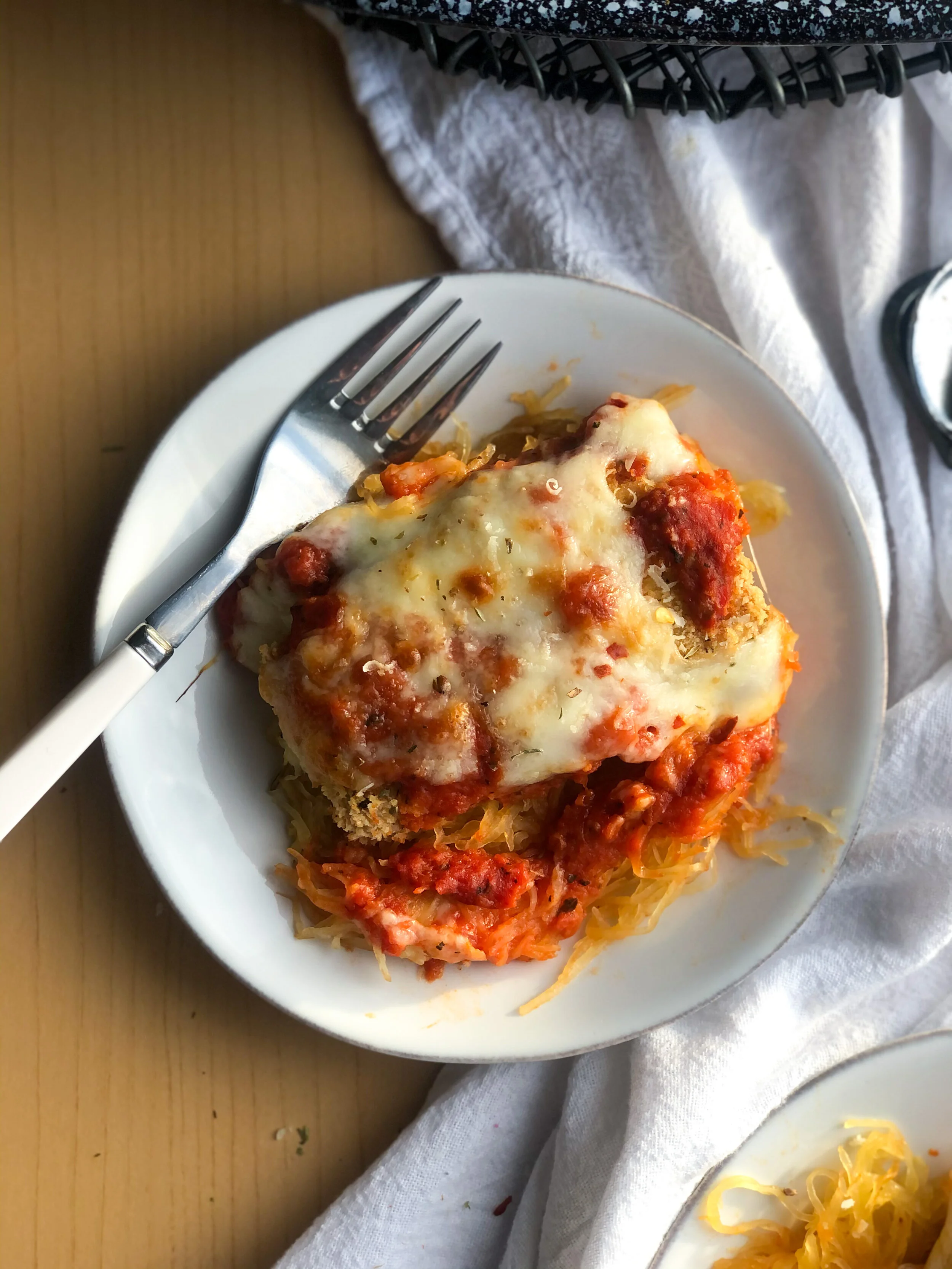Vegetarian Tofu Parmigiana and Spaghetti Squash Casserole
I've never been a huge spaghetti squash fan. In the past, my spaghetti squash dishes have always ended up watery, mushy or just plain boring. But in an effort to escape the grocery store in as little time as possible (no thanks, COVID), a spaghetti squash somehow ended up in my cart, on the conveyer belt and eventually in my oven.
When I was preparing that squash a few weeks ago, I referenced a few other blogs to see what I was missing. One of the first articles I stumbled upon was Love and Lemons's How to Cook a Spaghetti Squash. She recommended undercooking the squash slightly to retain a firmer texture. Genius! I tried out this method with a simple marinara sauce and was hooked.
In the weeks since then, I've had a few different spaghetti squash variations. This tofu and parmesan rendition is the best yet. It's prepared similar to eggplant or chicken parmigiana but uses breaded and baked tofu in place of the eggplant or chicken. The result is a filling and healthy Italian-inspired dish that's perfect for a chilly winter evening.
Let me know what you think of the recipe and don’t forget to follow the sustainability tips below!
Time: 1.5 hours
Makes: 4-6 servings
Ingredients
1 large spaghetti squash
15 ounces tofu, pressed
2/3 cup panko
2 tablespoons Parmesan cheese
1/2 teaspoon dried oregano
1/2 teaspoon dried thyme
1/2 teaspoon salt
1/2 teaspoon garlic powder
1/4 teaspoon onion powder
1/2 cup flour
1-2 eggs
1 1/2 cups marinara sauce, storebought or homemade
1/4 pound block or ball of mozzarella cheese
Methods
Don't forget to press your tofu for 1-2 hours before making this recipe. To press tofu, wrap it in a clean cloth and weigh down with a heavy pan.
Preheat oven to 400 F. Cut the spaghetti squash in half lengthwise. Drizzle the cut sides with a bit of olive oil and sprinkle with salt. Place face-down on a lined baking sheet and bake for about 30 minutes, or until the skin is beginning to brown and the flesh releases easily from the sides.
While the squash is cooking, prepare your tofu. Cut the tofu into 1/2-inch-thick planks (I cut mine into 6 even rectangles). In a small, shallow bowl, combine the panko, parmesan, spices and salt. In another bowl, crack 1 egg. Place the flour in a third bowl.
Working with one piece at a time, coat each slice of tofu in the flour, then the egg, and then the panko mixture. Place the coated tofu on a lined baking sheet. If you run out of egg, crack another into the bowl. If not, save the second egg for another meal.
Bake the tofu for 15 minutes. Then, flip and bake for another 15 minutes, or until golden brown and crispy.
Once the spaghetti squash is cooked, remove it from the oven and let sit until cool enough to handle. Then, scrape out the flesh into an 8-inch by 8-inch baking dish.
Once the tofu is cooked, arrange the slices on top of the spaghetti squash, slightly nestling them into the squash. Spoon the marinara in blobs around the casserole. Leave some of the tofu uncovered so it remains crispy. The more uncovered your tofu, the crunchier the final product will be. Use your hands to break apart the mozzarella and arrange it on top of the casserole. Grate some additional parmesan on top. Bake for 15-20 minutes, or until the cheese is melted and beginning to brown. Dig in!
Sustainability Tips
Spaghetti Squash: Your best option is to grow the spaghetti squash yourself, but any local squash is a great option. Also, be sure to make this recipe during the fall or winter because that's when spaghetti squash is in season. This way, your squash won't have to contribute as much to GHG emissions during travel.
Flour: I like to buy King Arthur brand flour because King Arthur Flour is a B Corp, which means that they're held to a high environmental and social standard. Alternatively, you could seek out a farmer who grows and mills flour locally. Buying locally can help connect you to your local food system and cut back on the miles your food has to travel.
Eggs: Local eggs are really easy to find if you look for them. Buying locally means your eggs won't have to travel as far, reducing greenhouse gas emissions and energy use.



